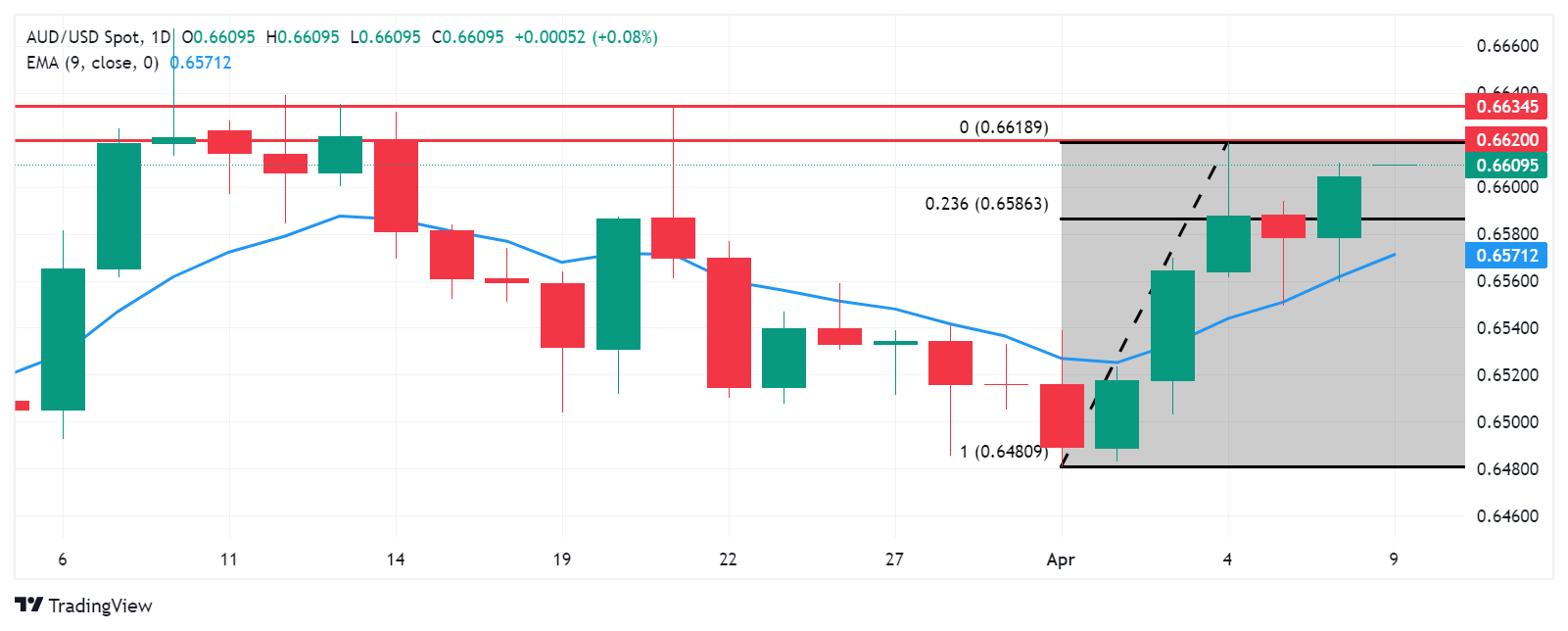- Australian Dollar holds ground amid improved risk appetite on Tuesday.
- Australia’s Westpac Consumer Confidence fell by 2.4% in April, against the previous decline of 1.8%.
- US Dollar receives downward pressure as volatility prevails ahead of US CPI.
The Australian Dollar (AUD) continues to hold onto its gains registered in the previous session despite the subdued Westpac Consumer Confidence released on Tuesday. The decline in the US Dollar (USD) provided support for the AUD/USD pair, which could be attributed to the improved risk appetite.
The Australian Dollar strengthens amid a higher domestic equity market. The ASX 200 Index positions for gains as investor attention remains fixed on the Reserve Bank of Australia’s (RBA) interest rate decisions. Investors are growing more doubtful about the need for the RBA to cut interest rates in 2024, especially after positive US data bolstered expectations that the Federal Reserve (Fed) may prolong its higher interest rate stance.
The US Dollar Index (DXY) encounters hurdles as the Federal Reserve carefully evaluates incoming data, prompting fluctuations in the market. Traders eagerly anticipate the release of the US Consumer Price Index data scheduled for Wednesday. They will also focus on Australian Consumer Inflation Expectations and Chinese consumer prices slated for Thursday.
Daily Digest Market Movers: Australian Dollar holds position amid weaker Consumer Confidence
- Australia’s Westpac Consumer Confidence declined by 2.4% in April, against the previous fall of 1.8%.
- Australian data showed on Friday that Trade Surplus (MoM) narrowed to 7,280 million in March, falling short of the expected 10,400 million and February’s reading of 10,058 million.
- Federal Reserve (Fed) Bank of Minneapolis President Neel Kashkari emphasized the importance of the central bank's commitment to combatting inflation. Kashkari stressed that despite the current inflation rate hovering around 3%, the Fed must strive to bring it back down to the target level of 2%.
- According to the CME FedWatch Tool, the likelihood of a 25-basis point rate cut by the Fed in June has reduced to 51.1%.
- US headline CPI is expected to experience an acceleration in March, whereas the core measure is expected to show a cooling down.
- US Nonfarm Payrolls (NFP) reported a significant increase of 303,000 jobs in March, surpassing expectations of 200,000 and the previous reading of 270,000.
- US Average Hourly Earnings rose by 0.3% month-over-month in March, meeting expectations. The previous reading was 0.2%. There was an increase of 4.1% on an annual basis, aligning with the market consensus but slightly lower than 4.3% prior.
Technical Analysis: Australian Dollar hovers above the psychological support of 0.6600
The Australian Dollar trades around 0.6610 on Tuesday. The AUD/USD pair may experience an upward movement, as it has recently tested the range around 0.6620 and 0.6630 multiple times throughout March. Moreover, the pair surpassed the nine-day Exponential Moving Average (EMA) in the previous week and has found support on it since then. The key resistance region is observed around the major level of 0.6650, followed by March’s high of 0.6667. On the downside, immediate support is identified around the psychological level of 0.6600, followed by the nine-day EMA at 0.6570 and the major support level of 0.6550.
AUD/USD: Daily Chart
Australian Dollar price today
The table below shows the percentage change of Australian Dollar (AUD) against listed major currencies today. Australian Dollar was the strongest against the Japanese Yen.
| USD | EUR | GBP | CAD | AUD | JPY | NZD | CHF | |
| USD | 0.03% | -0.02% | 0.02% | -0.03% | 0.03% | -0.11% | -0.05% | |
| EUR | -0.03% | -0.04% | -0.01% | -0.06% | 0.00% | -0.14% | -0.08% | |
| GBP | 0.02% | 0.05% | 0.04% | -0.01% | 0.05% | -0.08% | -0.03% | |
| CAD | -0.02% | 0.02% | -0.05% | -0.04% | 0.00% | -0.11% | -0.09% | |
| AUD | 0.00% | 0.04% | -0.01% | 0.02% | 0.04% | -0.10% | -0.05% | |
| JPY | -0.03% | 0.02% | -0.04% | -0.01% | -0.04% | -0.12% | -0.09% | |
| NZD | 0.09% | 0.12% | 0.07% | 0.10% | 0.05% | 0.12% | 0.02% | |
| CHF | 0.05% | 0.09% | 0.05% | 0.09% | 0.03% | 0.10% | -0.04% |
The heat map shows percentage changes of major currencies against each other. The base currency is picked from the left column, while the quote currency is picked from the top row. For example, if you pick the Euro from the left column and move along the horizontal line to the Japanese Yen, the percentage change displayed in the box will represent EUR (base)/JPY (quote).
Australian Dollar FAQs
One of the most significant factors for the Australian Dollar (AUD) is the level of interest rates set by the Reserve Bank of Australia (RBA). Because Australia is a resource-rich country another key driver is the price of its biggest export, Iron Ore. The health of the Chinese economy, its largest trading partner, is a factor, as well as inflation in Australia, its growth rate and Trade Balance. Market sentiment – whether investors are taking on more risky assets (risk-on) or seeking safe-havens (risk-off) – is also a factor, with risk-on positive for AUD.
The Reserve Bank of Australia (RBA) influences the Australian Dollar (AUD) by setting the level of interest rates that Australian banks can lend to each other. This influences the level of interest rates in the economy as a whole. The main goal of the RBA is to maintain a stable inflation rate of 2-3% by adjusting interest rates up or down. Relatively high interest rates compared to other major central banks support the AUD, and the opposite for relatively low. The RBA can also use quantitative easing and tightening to influence credit conditions, with the former AUD-negative and the latter AUD-positive.
China is Australia’s largest trading partner so the health of the Chinese economy is a major influence on the value of the Australian Dollar (AUD). When the Chinese economy is doing well it purchases more raw materials, goods and services from Australia, lifting demand for the AUD, and pushing up its value. The opposite is the case when the Chinese economy is not growing as fast as expected. Positive or negative surprises in Chinese growth data, therefore, often have a direct impact on the Australian Dollar and its pairs.
Iron Ore is Australia’s largest export, accounting for $118 billion a year according to data from 2021, with China as its primary destination. The price of Iron Ore, therefore, can be a driver of the Australian Dollar. Generally, if the price of Iron Ore rises, AUD also goes up, as aggregate demand for the currency increases. The opposite is the case if the price of Iron Ore falls. Higher Iron Ore prices also tend to result in a greater likelihood of a positive Trade Balance for Australia, which is also positive of the AUD.
The Trade Balance, which is the difference between what a country earns from its exports versus what it pays for its imports, is another factor that can influence the value of the Australian Dollar. If Australia produces highly sought after exports, then its currency will gain in value purely from the surplus demand created from foreign buyers seeking to purchase its exports versus what it spends to purchase imports. Therefore, a positive net Trade Balance strengthens the AUD, with the opposite effect if the Trade Balance is negative.
Information on these pages contains forward-looking statements that involve risks and uncertainties. Markets and instruments profiled on this page are for informational purposes only and should not in any way come across as a recommendation to buy or sell in these assets. You should do your own thorough research before making any investment decisions. FXStreet does not in any way guarantee that this information is free from mistakes, errors, or material misstatements. It also does not guarantee that this information is of a timely nature. Investing in Open Markets involves a great deal of risk, including the loss of all or a portion of your investment, as well as emotional distress. All risks, losses and costs associated with investing, including total loss of principal, are your responsibility. The views and opinions expressed in this article are those of the authors and do not necessarily reflect the official policy or position of FXStreet nor its advertisers. The author will not be held responsible for information that is found at the end of links posted on this page.
If not otherwise explicitly mentioned in the body of the article, at the time of writing, the author has no position in any stock mentioned in this article and no business relationship with any company mentioned. The author has not received compensation for writing this article, other than from FXStreet.
FXStreet and the author do not provide personalized recommendations. The author makes no representations as to the accuracy, completeness, or suitability of this information. FXStreet and the author will not be liable for any errors, omissions or any losses, injuries or damages arising from this information and its display or use. Errors and omissions excepted.
The author and FXStreet are not registered investment advisors and nothing in this article is intended to be investment advice.
Recommended content
Editors’ Picks

EUR/USD bounces off lows, retests 1.1370
Following an early drop to the vicinity of 1.1310, EUR/USD now manages to regain pace and retargets the 1.1370-1.1380 band on the back of a tepid knee-jerk in the US Dollar, always amid growing optimism over a potential de-escalation in the US-China trade war.

GBP/USD trades slightly on the defensive in the low-1.3300s
GBP/USD remains under a mild selling pressure just above 1.3300 on Friday, despite firmer-than-expected UK Retail Sales. The pair is weighed down by a renewed buying interest in the Greenback, bolstered by fresh headlines suggesting a softening in the rhetoric surrounding the US-China trade conflict.

Gold remains offered below $3,300
Gold reversed Thursday’s rebound and slipped toward the $3,260 area per troy ounce at the end of the week in response to further improvement in the market sentiment, which was in turn underpinned by hopes of positive developments around the US-China trade crisis.

Ethereum: Accumulation addresses grab 1.11 million ETH as bullish momentum rises
Ethereum saw a 1% decline on Friday as sellers dominated exchange activity in the past 24 hours. Despite the recent selling, increased inflows into accumulation addresses and declining net taker volume show a gradual return of bullish momentum.

Week ahead: US GDP, inflation and jobs in focus amid tariff mess – BoJ meets
Barrage of US data to shed light on US economy as tariff war heats up. GDP, PCE inflation and nonfarm payrolls reports to headline the week. Bank of Japan to hold rates but may downgrade growth outlook. Eurozone and Australian CPI also on the agenda, Canadians go to the polls.

The Best brokers to trade EUR/USD
SPONSORED Discover the top brokers for trading EUR/USD in 2025. Our list features brokers with competitive spreads, fast execution, and powerful platforms. Whether you're a beginner or an expert, find the right partner to navigate the dynamic Forex market.




